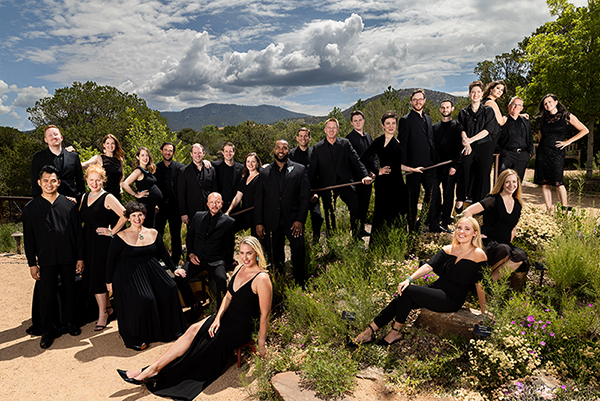It’s no secret that sustainable access to water in New Mexico is crucial to our future. With the U.S. Environmental Protection Agency suggesting that 50 percent of water loss comes from outdoor water use, cities throughout the state are advocating innovative education for residents to consider new approaches to water conservation. Let’s see what communities around the state are doing to conserve water.
Santa Fe Water Conservation

“What makes Santa Fe unique is that we have developed a structure that really lends itself to public input,” said Christine Chavez, City of Santa Fe water conservation manager. “We call ourselves a public input-driven program because our whole plan was developed with public input. Is there a request to create urban forests? Then let’s create a program to pick, plant, and maintain the right tree.”
Christine explained that collaboration with the business community is one of the most prominent indicators of success. Since 2018, their Certified Waterwise program pilot project has saved 2.1 million gallons of water annually. “The Waterwise program is huge,” she said. “When a business participates in that audit, we give them the window clings and a lot of free advertising. Businesses are calling us because the public demonstrated that they wanted the businesses to be engaged in the water conservation program. The businesses listened to their customers.
“We have a vested community; it’s part of the culture here to think about water as a precious resource,” Christine continued. “We have had strong water conservation ordinances for over 10 years. For example, you can’t serve water in a restaurant unless it’s upon request.” The city also has a training program through the community college, enabling those certified to do water conservation audits on the city’s behalf, from hotels to restaurants. The Water Conservation Department is also implementing eight different pilot programs in Santa Fe neighborhoods. Christine explained that pilot programs provide data that informs their conservation plans.
“Different parts of the city require different types of outreach; a blanket approach doesn’t work. For example, one part of the city is just typically hotter than the other because it’s not as close to the mountains,” she said. “With our tree pilot giveaway, where we gave away native pollinator trees, a rain barrel, and provided each participant planting education, we will learn about how well residents did with their trees. During this two-to three-year project, we’ll figure out how many of those trees survived. That can inform a bigger program that receives its dedicated funding. ”Christine, who has worked in water conservation for 15 years, said this is an amazing time to be in her field.
“What’s exciting for me right now is there’s a lot of collaboration,” she said. “Many municipalities are part of the New Mexico Water Conservation Alliance;
through that, we get to work with experts across the state to get ahead of the challenges. We can put in new programs, pilot new ideas, and learn from each other and lend our expertise to state policy.”
For more information on the City of Santa Fe’s Water Conservation program, go to savewatersantafe.com.
Albuquerque Water Conservation
When the pandemic kept everyone indoors, it was time for Albuquerque Bernalillo County Water Utility Authority (ABCWUA) to reach out online. “Our 505 Outside website is the resource for desert-friendly landscapes here in the Albuquerque area,” said Carlos A. Bustos, ABCWUA water conservation program manager. “We do a monthly newsletter, asking experts from the region and our staff about different topics like plant selection or irrigation systems. It goes out to 100,000 households every month.”
Carlos explained that an accompanying class, “Three Steps to Landscape Success,” launched during the pandemic and has seen tangible results. The steps are easy for most to do quickly: servicing your irrigation by checking for leaks or malfunctions, setting an irrigation timer, and selecting desert-friendly plants. “We’ve had over 2,500 people join us online, and we see a two- or three-percent reduction on the accounts of those participating
in the classes,” he said.
For landscape professionals, the Water Smart Academy program is where they can learn best management practices and are kept up to date on the most recent information when it comes to designing, installing, and maintaining landscapes, and making decisions for their clients that are going to result in more water efficiency. “I’m most proud of the work we’ve done with agency partners, the City of Albuquerque Parks and Recreation Department,” said Carlos. “In the last six years, they have reduced their water footprint consistently, by one to two percent per year, and we’re talking about an agency that uses almost 2 billion gallons of water per year and manages 2,000 acres of green spaces.”
Carlos said that during COVID, they made considerable strides in identifying and fixing leaks in schools in a partnership with the Albuquerque Public Schools. “We visited over 100 schools and performed complete assessments of their schools to identify leaks. That alone saved almost 15 million gallons in a year and a half.”
“We want to become a resource for residents, businesses, and other government agencies to come together and become more effective in water conservation through education,” Carlos said.
For more information on water conservation in Albuquerque, go to 505outside.com.
 Bernalillo County Water Conservation
Bernalillo County Water Conservation
“In the US, we’ve made these tremendous gains with indoor water conservation because of the improvements in the water efficiency of plumbing fixtures and appliances since the mid-1990s. There’s been more of a shift towards outdoor water conservation,” said Megan Marsee, Bernalillo County water conservation and resource manager. However, her water users are a little different than those in urbanized areas.
“In 2006, the Bernalillo County Commission created a program to provide water conservation resources to private well owners and customers of small water systems in unincorporated Bernalillo County, which serves roughly 17,000 properties,” said Megan. “Our focus is a little bit different because our service area includes a little pocket of urbanized area, but it also includes the far South Valley and the East Mountains, which are semi-rural.” Megan explained that, for their users, they updated water conservation incentive programs for high-efficiency toilet retrofits, high-efficiency washing machines, smart water monitors, rain barrels, smart irrigation controllers, and laundry-to-landscape gray water kits.
While rain barrels are the most popular, she said that more people are becoming curious about laundry- to-landscape kits, especially those on septic. “The idea makes a lot of sense for our users, it’s just separating off a portion of their wastewater stream, and instead of sending that into their septic system, they get to support landscape irrigation.”
Go to the website for more information on Bernalillo County’s water conservation program.
Las Cruces Water Conservation
In the City of Las Cruces, the Water Conservation Program (WCP) focuses on educating young and old about seeing water as a vital resource, and it uses new technology with an online tracking system to contact residents who might be having a leak they don’t even know about yet.

“Water is lost through leaks, with some of the main culprits being old toilets,” said Rhonda Diaz, Las Cruces Utilities (LCU) WCP coordinator. “Our automated meter reading and our online UtilityHawk portal enable our residents and staff at Las Cruces Utilities to monitor usage to help prevent water loss. If there’s a large spike in the usage, even if residents don’t see the water in their yard, it might be an underground leak.”
In the last year, Rhonda’s staff has incorporated customer service representatives to contact residents who appear to have a leak but may not be monitoring their water usage. They also conduct observations to find irrigation system malfunctions and water loss throughout the city, even at night. “For us, education is key,” said Rhonda. “We’re looking forward to having our Water Festival start again after COVID. It’s a rite of passage for all fourth graders in Las Cruces to learn about how water affects their lives and how precious it is.” As a day-long event, the festival features informative exhibits and hands-on activities about hydrology, cultural uses of water, local geography, and environmental impacts.
“For example, some of our water production staff show how much water is lost when people don’t shut off the tap while brushing their teeth,” Rhonda explained. “It gives the kids something to think about and they tell their parents.” Rhonda and her staff also go to local schools on Enrichment Wednesdays to talk about how students might best conserve water in the future. “We tell them that they’re the ones who will be innovating the technology of the future,” she said.
Adults don’t miss out on the fun either. Each year the LCU WCP hosts the Lush & Lean Workshop series, inviting local experts to talk directly to residents about specific topics like water-wise landscaping, what grows best in the area, how to have healthy soil, and how to harvest rainwater.
For more information on the City of Las Cruces Water Conservation Program, visit lascruces.gov/1285/Water-Conservation.
Story by Cassie McClure
Courtesy photos
Originally published in Neighbors magazine

 Bernalillo County Water Conservation
Bernalillo County Water Conservation













